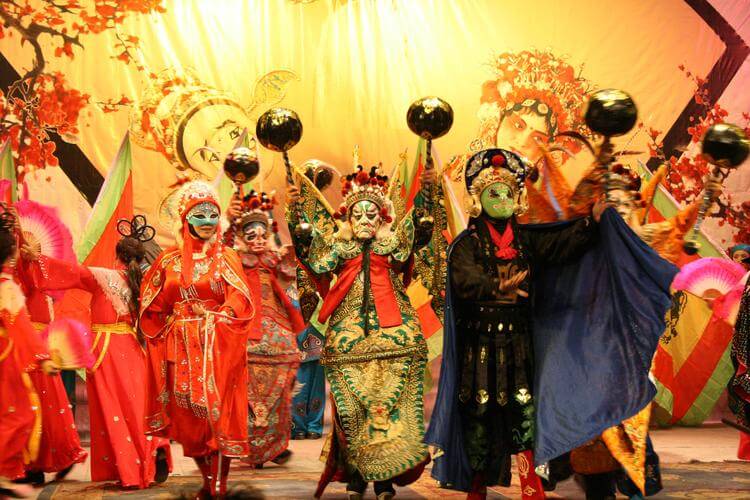Brief Introduction About Dun Huang

The national, historical city of Dunhuang is a renowned tourist city famous for the Mogao Caves. It is situated in the common boundary of Gansu Province, Qinghai Province and Xinjiang Province. Dunhuang, long ago referred to as 'Sha Zhou' (beautiful desert oasis), was the hub of middle and eastern silk routes in ancient times.
- The city landmark is an attractive statue, the idea of which comes from the mural in Mogao Caves, a shrine to the culture and arts of Dunhuang. From Mt.Qilian in the south, Mt. Mazong in the north and desert from east to west, the landform of Dunhuang City is a declining basin-plain from west to northeast, high in the north and south, and low in the middle. The western cities of China, especially those in the desert, are known for their sandstorms, so tourists should protect themselves with glasses, hats and gauze kerchiefs, etc.

- In ancient times, Dunhuang was the center of trade between China and its western neighbors. At that time, it was the most westerly frontier military garrison in China. With the flourishing of trade along the Silk Road, Dunhuang was prompted to become the most open area in international trade in Chinese history. It provided the only access westward for the Chinese Empire and eastward for western nationalities. Today, as a reminder of this historical area, we are left with the Mogao Caves, Yangguan Pass, Yumenguan Pass and many wonderful Chinese poems depicting the time. Although what remains of the two Passes are crumbling walls, one can still experience the atmosphere of that time while visiting in person.
- Today, Dunhuang is a typical tourist city, clean and beautiful. Because of its splendid stone caves, tourism has become an indispensable industry to Dunhuang City. Surrounding establishments include various classes of hotels and restaurants for your choosing. As well, tourism personnel are knowledgeable and well trained these days. For a western city in China, it has become more accesible for people to come and go as they please. Transportation is much more efficient, ensuring that your wonderful trip runs smoothly. May to September is the best time to visit, so be sure to plan your trip during these months. Including Dunhuang City in your tour is a decision you won't regret!
- Dunhuang City, an obvious pearl on the Silk Road, opens her arms to welcome tourists from all over the world.

- The first recorded history of Dunhuang, a vital station along the legendary Silk Road, was related by Emperor Wu of the Han Dynasty (206 B.C. – 220). However, modern archaeological findings trace the region's history as far back as the Xia Dynasty (21st – 16th century B.C.). During the Shang and Zhou Dynasties over the next 1,400 years, the area was inhabited by three nomadic tribes—the Qiang, Wusun and Yuezhi (Rouzhi). At the end of the Qin Dynasty (221 B.C. – 206 B.C.), the Yuezhi conquered the other two tribes and occupied the entire Hexi Corridor. This corridor (also called Gansu Corridor) was the primary segment of the ancient Silk Road. Later, the Hun (or Xiongnu) armies vanquished the Yuezhi and established dominance here during the early Han Dynasty. From the early seventh century B.C., Chinese kingdoms built walls along their northern frontiers to defend themselves against the warlike Huns. During the Han Dynasty, the most ambitious Great Wall project to date was begun with four systems of fortification spanning from Dunhuang in the west all the way to the Korean peninsula in the east.

- Dunhuang's importance as a military fortress led to its becoming a prefecture in 177 B.C. concurrently, construction of the Yumenguan Pass and Yangguan Pass to the west of Dunhuang opened a new trade route between the central plains (Hexi) and the states in Xi Yu (literally the western regions, referring to most parts of Xinjiang and part ofcentral Asia) namely the noted Silk Road. As more and more immigrants from the central plains settled here, Dunhuang gradually became a prosperous agricultural base as well as the key military installation on the Han's border frontier. For the next several centuries, Dunhuang served as one of China's most important military, political and economic centers.

- Commercial development in the Han Dynasty was soon accompanied by the growth of religion. The arrival of Confucianism initially and later Taoism and Buddhism would play an important role in Dunhuang's development. During this period, however, political turbulence prevailed as five different regimes rules the region. At this time Buddhism began to gain a strong foothold and its earliest grottoes were built in the nearby Magao Caves. In the ensuing years, the Silk Road flourished as the popularity of Buddhism increased. More Buddhist writings and music were brought to Dunhuang with the encouragement of the Sui (561 – 618) and Tang (618 – 907) Dynasties, more and more local people began to embrace Buddhism.
- The Tang continued its dominance of the region fending off military attacks including a defeat of the Tufan (the ancestors of Tibetans). Dunhuang and the Hexi Corridor would remain vital military fortresses. During this time, the art, ideas and cultures of other civilizations such as Greece, India, and central and western Asia were imported into Dunhuang.Eminent Buddhist monks continued to come here to carry forward their dharma. The Magao Caves, the greatest example of Buddhist cultural significance, continued to house religious statuary and frescoes in its grottoes.

- In the Southern Song Dynasty (1127 – 1279), warfare in the region became more frequent and commerce was gradually shifting from land to sea routes. This resulted in Dunhuang gradually losing its national stature as the economic gateway to the western regions. During the Ming Dynasty (1368 – 1644) nomadic Mongolian tribes occupied the region. After the Mongolian occupation, Islamic tribes conquered the region in 1516. This event marked the end of the centuries-long presence of Buddhism in Dunhuang. Much Buddhist art and religious relics destroyed although some reconstructed works were salvaged in the Qing Dynasty (1644 – 1911). While Dunhuang never regained its commercial and military status, it does remain a premier tourist destination largelybecause of the peerless Magao Caves.






































Leave a comment